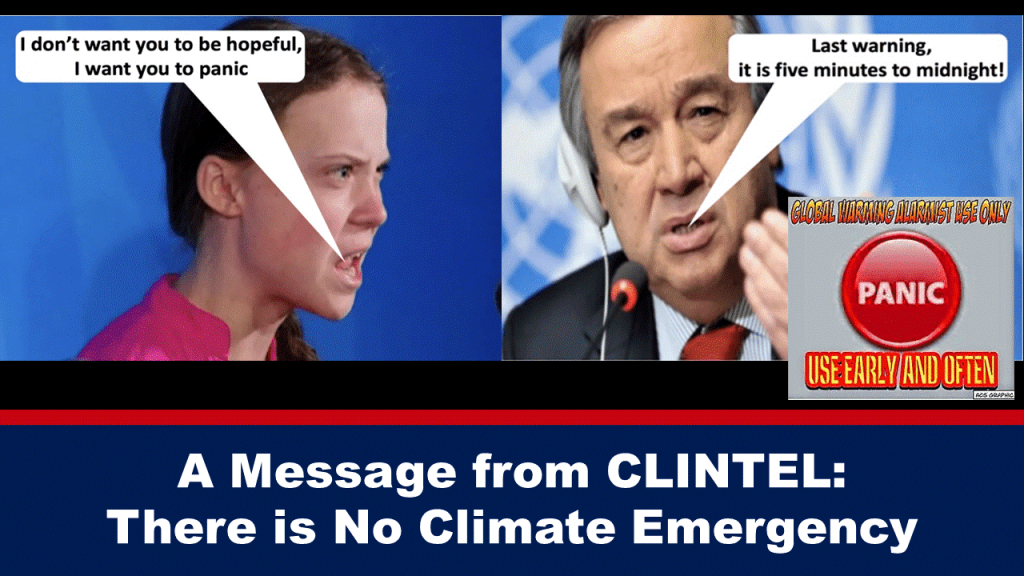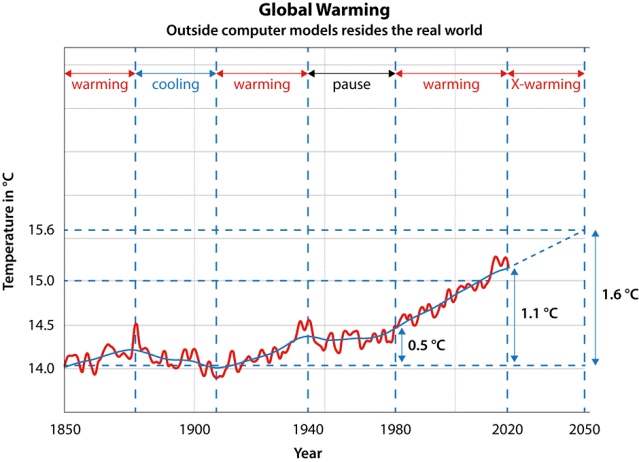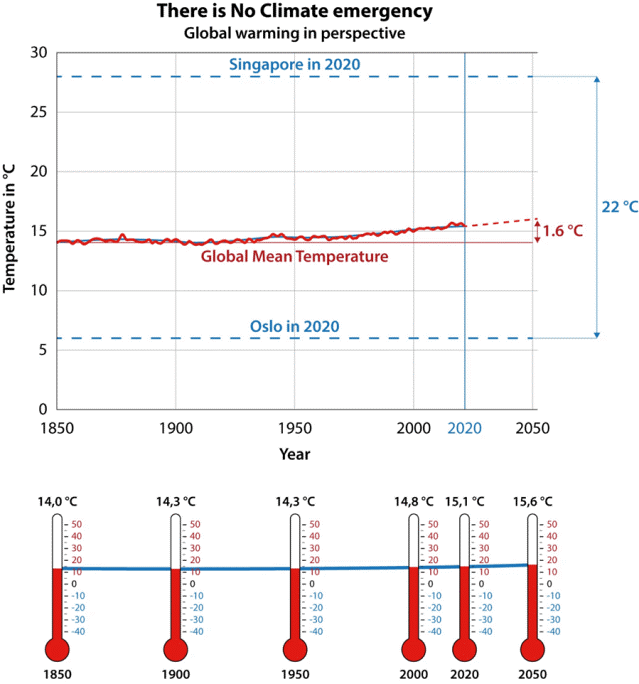A Message from CLIENTELE: There is No Climate Emergency
by
Robert Gorter, MD, PhD.
(with thanks to the Expose)

The President of Climate Intelligence (“CLIENTELE”), Guus Berkhout, has published a message to all the people of the world. His message is simple: There is no climate emergency.
For decades, the public has been flooded with fear-mongering stories from climate alarmists who claim “catastrophic doom” due to increasing carbon dioxide (CO2) levels from human activities. The climate alarmists deliberately cause panic, “time is running out,” they claim. The solution, climate alarmists say, is the “net zero” policy.
Thousands of independent scientists disagree. As of 1 October 2022, more than 1,400 scientists from around the world have signed the ‘World Climate Declaration’ which begins: “Climate science should be less political, while climate policies should be (much) more scientific.”
CLIENTELE has called for an open scientific debate, but the World Economic Forum (WEF), for example, chooses to ignore climate science and follow climate politics with its catastrophically damaging “net zero” ideology.
As well as CLINTEL’s founder and president, Guus Berkhout is a professor emeritus of geophysics and a member of the Royal Netherlands Academy of Arts and Sciences (KNAW). In his message to the world below Berkhout explained why is there such a big difference between the scary climate activists’ narrative and the optimistic climate scientists’ message who believe there is no climate emergency.

Augustinus Johannes “Guus” Berkhout (*1940)
Guus Berkhout is a Dutch engineer who has worked for the oil and gas industry and is a very well respected professor.
Berkhout started his career working for Shell. Between 1976 and 2007, he served as a professor of acoustics, geophysics, and innovation management, at Delft University of Technology. From 2000 to 2002 he was chair of a commission dealing with projected sound norms at Amsterdam Airport Schiphol, from which he resigned after feeling the commission’s independence was undermined by the Ministry for Transport and Water Management. In 2019, Berkhout co-founded the climate skeptic organization Climate Intelligence Foundation (CLIENTELE).
Career
In 1964 Berkhout started working for Royal Dutch Shell. In 1976 he returned to Delft University of Technology and became a professor of acoustic imaging and sound control. In 1987 he also became a professor of geophysics. In 1998, he joined the board of the university, and he stepped down in 2001, before the end of his term, due to differences with other board members in the vision of the future of the university. In 2001, he became a professor of innovation management and he retired from the university in 2007. Berkhout has pleaded against the increase of bureaucratic processes at universities.
During his time at Delft University, Berkhout was the founder and scientific director of the Delphi Consortium, which does seismic research for a consortium of oil and gas companies.
Public sector
Berkhout was chair of the independent Commission Experts Airplane sound from mid-2000 to December 2002. At the request of the House of Representatives, the Dutch Minister for Transport and Water Management, Tineke Netelenbos, instigated the commission. The commission was to look into the sound norms for Amsterdam Airport Schiphol for the upcoming five years. Berkhout resigned as chair after having the feeling that the independence of the commission was hindered by the Ministry, and having to wait for approval of a measurement plan for over half a year. The whole commission resigned, citing they had been actively worked against by the Ministry for political reasons.
For the 2006 Dutch general elections Berkhout had planned to form a new party with several scientists and entrepreneurs but did not enter the elections, seeing the huge increase in new parties contesting the election.
A Message from Guus Berkhout, President of CLIENTELE: There is No Climate Emergency!
In the past decades, the public has been flooded with fear-mongering stories, telling them that global temperatures will rise to catastrophically high levels.
Climate activists claim that the cause of all this impending doom is the increasing amount of CO2 produced by human activities. The proposed solution is the so-called net-zero emission policy, aimed at lowering human net CO2 emissions to the levels of the pre-industrial era of the late 1700s.
Those activists also claim that people should panic, and that time is running out: “Be aware that it is five minutes to midnight, we must act without delay!” Many thousands of scientists disagree; more than 1400 are CLIENTELE signatories.

Antonio Guterres, the big boss of the UN

Greta Thunberg, teen climate activist, living with autism
In his numerous “last warning” speeches, Antonio Guterres refers to computer simulations, not the real world. Greta Thunberg testified to the US Congress that there was “no science” behind her “panic” comment. This information cannot be found in the media.
So; why is there such a big difference between the scary climate activists’ narrative and the optimistic climate scientists’ message, who believe there is no climate emergency? Please, before you continue reading, watch our message ‘Consensus meet CLINTEL’:
Friends of Science: Consensus meet CLIENTELE, 26 August 2022 (2 mins)
Not many citizens are aware that all the frightening climate predictions have been generated by computer models. And we know from experience in many other complex areas, how misleading computer models can be.
For example, think of the many wrong predictions by economic models or think of the large mistakes in recent pandemic modeling. The output of computer models depends fully on the assumptions that modelmakers put into them. In the past 50 years, the predictions of climate models about global warming and their dire effects have all been wrong. In the engineering community, they would be qualified as useless.
More specifically, the assumptions in climate modeling are such that predicted temperature changes turn out to be persistently too high. Even worse, extreme weather events – such as heatwaves, droughts, floods, hurricanes, etc. – are intentionally used to support extreme climate predictions. But if we position the current extreme weather events in a historical context, we see that these events are ‘climate business as usual. See Goklany, 2020.
[Related: Study Disputes That Earth Is in a ‘Climate Emergency’, Breitbart, 7 February 2021]
The conclusion is that models (computer simulations) run “too hot” and that predictions of adverse effects on humans are highly dubious. They project a catastrophic future that is not born out by observations. It is much wiser and safer to rely on measurements. The history of science tells us that significant steps forward are always fuelled by observations from new measurement instruments.
Think of the very recent spectacular images of outer space by the new James Webb Space Telescope. The same good news applies to modern satellites that deliver high-quality measurements around the Earth since 1979. Satellite data shows NO extreme warming, and this is cross-checked by millions of weather balloon measurements.
Therefore, let us make use of the abundant temperature measurements made through the years. From the beginning of the industrial period (1850) until the present (2020) we see in Figure 1. Measurements tell us that the temperature in 2020 is 1.1oC higher than in 1850.

Figure 1: Global temperature curve as currently generally accepted from 1850-2020. If we extend the measurements to 2050, we see that the temperature is 1.6 C higher than in 1850 (‘X-warming’).
Using Figure 1, let us extrapolate the satellite temperatures to the year 2050 by assuming that the temperature increase of the past 40 years (1980-2020) will carry on without any pausing and cooling. This generous projection results in a 2050 temperature that is 1.6oC higher than in 1850. Now, here is the big question: ‘Is the global warming of 1.6oC a scary result? Does this outcome really tell us that it is “five minutes to midnight”?
Let us look at today’s difference in mean temperature between Oslo (one of the big cities near the North Pole) and Singapore (one of the big cities near the Equator), see Figure 2. Measurements show that the difference is as much as 22oC, twenty times bigger than the global warming between 1850 and 2020 and almost 14 times bigger than the so-called “scary” global warming between 1850 and 2050.
Despite this huge mean temperature difference of 22oC, both cities are very prosperous and the citizens in both cities are enjoying life. So, why do the media tell us that global warming of 1.6oC or more will lead to a disaster (“the end is near”), while the 22oC difference between Oslo and Singapore turns out to be no problem whatsoever?

Figure 2: Global mean temperature from 1850-2050, together with the average temperature of the prospering cities of Oslo and Singapore in 2020. Note that the global warming of 1.6 °C is marginal with respect to the difference of 22 °C between the two cities (almost factor 14)
The answer is adaptation! Mankind shows an impressive history, having survived many big changes in its living environment, including big changes in the Earth’s climate. Thanks to our ingenuity, human beings have always found clever solutions to cope with all past challenges, again and again. If you visit Oslo and Singapore, you see an impressive demonstration of human’s capability to adapt to climate differences of 22oC.
There is another interesting observation to make. Gradual global warming is not a serious problem, whether it is caused by CO2 or not. Not mitigation but adaptation is the solution. So, for all of those who would like to think that the present global warming is fully caused by CO2, our conclusion stays unchanged.
Bear in mind that during the cooling period around 1900 and the temperature pause in the sixties (see Figure 1), the CO2 concentration in the atmosphere continued to increase without delay. Hence, the anomalous temperature behavior in these two periods was indisputably caused by mother nature. The same applies to the large climate difference between Oslo and Singapore.
Finally, for those who still believe that CO2 emissions are pollution, we urge you to remember that CO2 is essential for all life on Earth. Additional CO2 in the air has promoted growth in global biomass. It is also very favorable for agriculture, increasing crop yields worldwide.
If also this fact of life is not sufficiently convincing, please realize that with the availability of modern nuclear power plants we have ample time to create a global energy system with largely zero emissions. But again, the big question is whether zero emission is a sensible goal.
In conclusion, do not let the terrifying stories of supranational institutions – such as the UN, EU, and WEF – scare you. Particularly, climate alarmists must not use extreme weather events to poison our children with fear:
The gradual global warming, which started around 1700 after the end of the Little Ice Age, is a fact and has not caused any serious problems. Our advice is: “Enjoy today’s climate because stories from the Little Ice Age tell us that a cold climate is full of hardship.”
If we continue to invest in innovation, mankind can easily cope with any effect of further warming. Hence, we must stop the demoralizing back-to-the-past mitigation solutions. We observe that it only leads to decline and poverty.
Instead, we must focus on the power of adaptation, based on science, technology, and education. It will lead us into an era of prosperity for nature and mankind. Please, join our journey!